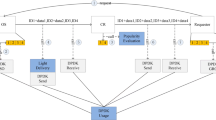Abstract
Video fingerprint is a mechanism to protect movie from the traitors and also have the capability to identify the traitors. The problem arises in video fingerprint when several traitors having the same copies of a movie with different fingerprints collude together. During the collusion the original fingerprints in the movie will be removed or attenuated. Due to this the traitors can illegally copy, duplicate, record or redistribute the movie without having legitimate permissions. To avoid illegitimate acts of the traitors, a new Video on Demand architecture is proposed in this paper. This new architecture combines the proxy caching mechanisms in the peer to peer network to support larger users group. A new video fingerprinting scheme is proposed for this architecture, which can strongly resist against collusion attacks from the traitors. To check the appropriateness of our scheme, we have analyzed some of the existing schemes. The appropriateness is analyzed in terms of efficiency, effectivity and performance. To evaluate the optimality of these schemes, we have carried out simulation for our architecture. The results from the simulation show the optimal outcome for our scheme than any existing schemes.













Similar content being viewed by others
References
Ashok Kumar R, Ganesan K (2010) Video segmentation using metropolis hastings algorithm for the VCR operations. Int J Adv Media Commun 4(3):274–297
Ashok Kumar R, Ganesan K (2010) A novel dynamic pricing scheme for contributing peers in the VoD System, springer international journal of multimedia tools and applications, doi:10.1007/s11042-011-0750-0
Ashok Kumar R, Hareesh K, Ganesan K, Manjaiah DH (2009) M-chaining scheme for VoD application on cluster-based Markov process. Int J Adv Media Commun 3(3):277–289
Camp LJ (2003) First principles of copyright for DRM design, in Internet Computing, IEEE. l.7(3):59–65
Choi CH, Oscar CA (1993) Adaptive image quantization using total variation classification. Proc Int Conf Signal Proc 2:796–799
Colbourn CJ, Dinitz JH (1996) The CRC handbook of combinatorial designs. CRC, Boca Raton
Dinitz JH, Stinson DR (1992) Contemporary design theory: a collection of surveys. Wiley, New York
He S, Wu M (2007) Collusion-resistant video fingerprinting for large user group. IEEE Trans Inf Forensics Security 2(4):697–709
Ho KM, Poon WF, Lo KT (2008) Investigating the performance of hierarchical video-on-demand system in heterogeneous environment, international conference in information networking, 2008. ICOIN, pp 1–5
Iwata T, Abe T, Ueda K, Sunaga H (2003) A DRM system suitable for P2P content delivery and the study on its implementation. The 9th Asia-Pacific Conference on Communications. vol.2, no., pp 806–811 Vol.2
Kang IK, Sinha K, Lee H-K (2006) New digital fingerprint code construction scheme using group-divisible design. IEICE Trans Fund E89-A(12):3732–3735
Liu X, Huang T, Huo L, Mou L (2007) A DRM architecture for manageable P2P based IPTV system. in IEEE International Conference on Multimedia and Expo, Beijing, pp 899–902
Liu J, Rao SG, Li B, Zhang H (2008) Opportunities and challenges of peer-to-peer internet video broadcast, Proceedings of the IEEE (Invited paper), Special Issue on Recent Advances in Distributed Multimedia Communications, Vol. 96, No. 1, pp 11–24
Liu Z, Wu C, Li B, Zhao S (2009) Distilling superior peers in large-scale P2P streaming systems, INFOCOM 2009, IEEE, pp 82–90
Narsimha C, Raju KS, Jawahar CV (2008) A real-time video encryption algorithm exploiting the distribution of the DCT Coefficients, In proc. of IEEE Region 10 Conference, HCU-Hyderabad, India
Nikolaidis N, Pitas I (2006) Image and video fingerprinting for digital rights management of multimedia data. Int Symp Intell Signal Proc Commun 801–807:12–15
Park H-J, Lee J-M, Choi J-K (2008) A video-on-demand transmission scheme for IPTV service with hybrid mechanism, IEEE international conference on communications, pp 1777–1781
Puri A, Aravind R (1991) Motion compensated video coding with adaptive perceptual quantization. IEEE Trans Circuits Syst Video Technol 1(4):351–361
Rodriguez P, Tan S-M, Gkantsidis C (2006) On the feasibility of commercial, legal P2P content distribution. SIGCOMM Comp Commun 36(1):75–78
Seol JM, Kim SW (2006) Scalable fingerprinting scheme using statistically secure anti-collusion code for large scale contents distribution. LNCS 4096:560–569
Shan H, Wu M (2006) Joint coding and embedding techniques for Multimedia Fingerprinting. IEEE Trans Inf Forensics Security 1(2):231–247
Tan SH, Pang KK (1996) Classified perceptual coding with adaptive quantization. IEEE Trans Circuits Syst Video Technol 6(4):375–388
Thouin F, Coates M (2007) Video-on-demand networks: design approaches and future challenges, in IEEE Network 21(2):42–48
Trappe W, Wu M, Ray Liu K (2002) Collusion-resistant fingerprinting for multimedia, in: Proceedings of the IEEE International Conference on Acoustics. Speech, and Signal Processing 4:3309–3312
Wong PHW, Oscar CA, Wong JWC (2000) Data hiding and watermarking in JPEG compressed domain by DC coefficient modification, proc. of spie conference of security and watermarking of multimedia contents, pp 237–244
Wu C, Li B (2008) On meeting P2P streaming bandwidth demand with limited supplies, in proceedings of the 15th annual SPIE/ACM international conference on multimedia computing and networking (MMCN 2008) Canada, pp 1–12
Wu C, Li B, Zhao S (2008) Exploring large-scale peer-to-peer live streaming topologies, in ACM transactions on multimedia computing. Commun Appl 4(3):1–23
Wu M, Trappe W, Wang Z, Liu KJR (2004) Collusion resistant fingerprinting for multimedia. IEEE Signal Proc Mag 21(2):15–27
Yang J, Xu X (2006) A robust anti-collusion coding in digital fingerprinting system, 8th international conference on signal processing, Beijing. 4:996–999
Yu Y, Lu H, Chen X, Zhang Z (2010) Group-Oriented Anti-Collusion Fingerprint Based on BIBD Code, In the 2nd International Conference on e-Business and Information System Security. 1–5, 22–23
Zhu G, Sang N (2008) Watermarking algorithm research and implementation based on DCT block, world academy of science, engineering and technology (45):38–42
Zou D, Prigent N, Bloom J (2009) Compressed video stream watermarking for peer-to-peer based content distribution network, IEEE International Conference on Multimedia and Expo, pp 1390–1393
Author information
Authors and Affiliations
Corresponding author
Rights and permissions
About this article
Cite this article
Kumar, R.A., Kaliyaperumal, G. Optimal fingerprint scheme for video on demand using block designs. Multimed Tools Appl 61, 389–418 (2012). https://doi.org/10.1007/s11042-011-0843-9
Published:
Issue Date:
DOI: https://doi.org/10.1007/s11042-011-0843-9




